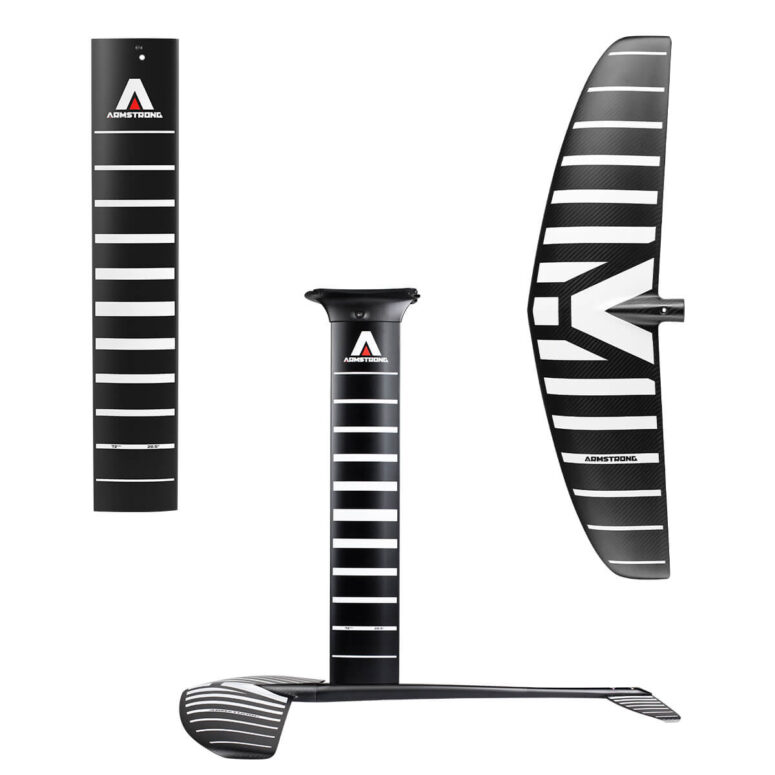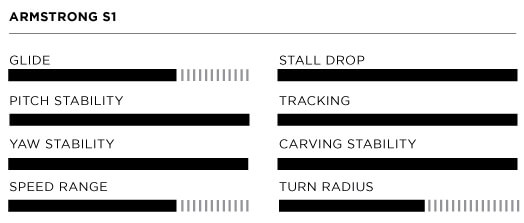

When you purchase gear through links on our site, we may earn a small commission. Here’s why you can trust our tests and our affiliate partner.

Armstrong have definitely always sat proudly in the premium sector when it comes to foils, with a built-to-a-design-and-specification rather than a price-point mantra that’s kept their high-end all-carbon offerings absolutely cutting edge over the last few years. This year heralds their first delve into the entry level and they’ve produced their first alloy mast and fuselage system to lure first timers on a budget over from low-cost rivals, and perhaps allow existing riders on their ecosystem to pick up a budget mast for family to learn on or justify that short mast they couldn’t quite squeeze into the balance sheet.
The mandatory complete backward compatibility and modularity is here with the hexagonal front wing connection sporting the same three vertical bolt and horizontal bolt-and-barrel nut configuration as its carbon brethren. To accommodate an alloy fuse and mast system a change of the usual architecture was required. The alloy fuse now bolts to the straight aluminum mast extrusion via a separate adapter that sits recessed in the top of the fuse. Two longer M8 bolts are utilized here with nylon washers to avoid wear on the fuselage apertures and provide a locking element to the system. The mast top is beautifully machined from aerospace grade aluminum with three T40 bolts threading into the mast section vertically, as well as a unique recessed T30 bolt in the sleeve to lock the mast in and squeeze any potential play out at this critical juncture. The tail attaches identically to the carbon system with two dome head T30 bolts and can receive the same shims. Fixings are comprised from a mixture of medical grade stainless steel and titanium which where necessary to avoid corrosion, and a little tube of Teflon lube is provided for good measure to be used liberally, meaning the system doesn’t need to be constantly disassembled. Our test set doesn’t show any signs of degradation after three months of abusive UK conditions. Three lengths of mast are available: 58, 72 and 85cm, and two fuselage options in 65 and 75cm.
Alloy systems are often an afterthought, or at best play second fiddle to their carbon counterparts. In this case it’s clear Armstrong have thrown all their design heritage at it and come out with something delightfully detailed and well thought out which doesn’t at any point feel like a huge compromise. In fact, the section of the alloy extrusion benefits from the same research as their high-end performance mast system.
The S1 (Step One) front wing shape seems a little reminiscent of the legacy HS range, but with a thicker profile and far more curvature built in. The downturned tips are smoothed off and safe to knock your legs against as well as aiding tracking, like mini fins. It sports a pronounced swept delta planform in the leading and trailing edge, and the short span per surface area of the lower aspect wing will minimize tip breaching, as at this stage of the game, that’s the last thing you want. Sizing comprises of a truly enormous 2450 down to a 1250 in four increments, giving plenty of options for a range of learner weights and disciplines.
The S1 300 stabilizer pairs perfectly with the new novice-focused front wing on the 75cm fuselage. This generously sized stabilizer has quite a bit of chunk through the profile and similarly ultra safe downturned tips to avoid those formative stabs to the shins.
In practice the S1 is exceptionally easy to use – in fact, if you struggle to get going with this setup, we’d perhaps recommend you trade it for a set of golf clubs and write off learning to foil completely – perhaps your path to enlightenment lies elsewhere. It’s as if Armstrong have mitigated all squirrelly behavior you normally experience from learning to foil and allowed you to put in significant errors in weight placement and get clean away with it. You can dance around all over the board like an elephant and it takes it like a champ, smoothing out all axis like it has a set of ailerons auto correcting the flight path. We’re not sure what wizardry Armstrong have applied to the stall characteristics, but it drops you as light as a feather with plenty of warning even on the 1250, and the low-end speed range is extremely composed and confidence building and will be particularly effective for people that take off with a little trepidation. It lifts smoothly and early and returns the favor on landing where it sinks rather than slaps. For a foil with such a comfortable low end, more magic has been applied in the top end, which doesn’t become unstable. It simply tops out and holds composure, feeling like you’re pushing water rather than turning bucking bronco. Swapping your feet for a foot switch, it’s amazing how heavy footed you could be and get away with it.
We’re used to high-end design and cutting-edge equipment from Armstrong, and their S1 Alloy foil kit is no exception, albeit from lower cost materials, which is potentially a greater challenge. A different direction for their R&D department for sure, but no less successful a design exercise than their more exotic offerings. Armstrong have made what’s perhaps the most accessible foil on the market, with a balance of characteristics to rival a circus tightrope walker. This is going to make learning foiling all the more achievable for even the most risk averse or penny pinching. We wish foils were this easy to ride when we were learning!
